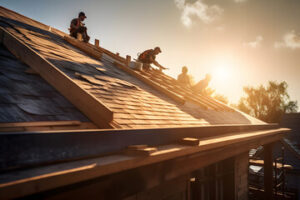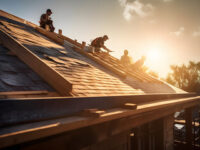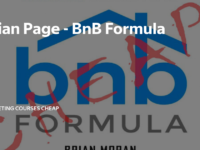Roof Repairs You Shouldn’t Do Yourself
Unless you’re experienced in roofing repairs, it’s best to leave significant roof repair jobs to the professionals. Trying to do too much yourself can lead to costly mistakes.
Conduct regular inspections and address any concerns as soon as you can. To do this, check around chimneys, old flashing, roof windows, pipes, vents, and skylights.
Flashing protects some of the most vulnerable parts of a roof, including valleys, chimneys, skylights, and other structures. It is made of sheet metal strips attached to a roof’s seams and edges. If it becomes damaged, the roof is more likely to leak around these areas. A professional roofing contractor will know how to spot this type of damage and repair it quickly.
Damaged flashing is usually the result of inclement weather or aging. It can also be caused by incorrect installation or physical damage. Regardless of the cause, any damage to flashing should be repaired immediately. Water leaks into these areas can damage the interior of a home and cause serious structural problems in the roof frame and other building components.
Common signs of flashing damage include discoloration on the ceiling and walls near where the flashing is installed. Internal leaking near windows, fireplaces, and skylights is another sign that the flashing has become damaged or worn out.
Roofing experts recommend having flashing repaired as soon as you notice it is damaged. This will help to prevent the issues mentioned above and will save you money on expensive roof repairs in the future.
A good roofer will replace the damaged flashing and seal it with a waterproof roof cement. They will also make sure that the new flashing is properly installed and that the roof shingles are nailed down securely.
Flashing comes in several different types and is nailed to the roof with roofing nails. This includes step flashing, which is used when the roof meets a vertical surface, such as a chimney or dormer. This method uses a series of overlapping sheets of metal to create “steps” that water can run down. A counter flashing system is also used, which sits over the base flashing to ensure water doesn’t seep through.
Flashing is designed to be tough and resist many of the same environmental factors that affect other roofing materials, such as acid rain, hail, severe heat, heavy snows, and salt air. However, it can still show signs of wear and tear over time and needs to be replaced as needed. An annual roof inspection by a professional can catch any problems with your flashing before they have the chance to grow into major leaks and other problems.
Leaking Gutters
Gutter leaks occur when the gutters become clogged with leaves, twigs, or other debris. When this happens, rainwater cannot flow freely from the roof through the gutters and downspouts. Instead, it backs up and seeps into the house, causing wood damage to fascia boards, water infiltration into the attic, and more. Fortunately, this is an easy fix with regular gutter cleaning and the use of gutter guards to keep out larger debris.
Cracks and holes in the gutters are another common problem. They can be caused by weathering, animal damage, and even overly strong storms. If left untreated, these holes can lead to rust and other serious problems. In some cases, you may be able to seal the hole with caulk or a waterproof gutter tape that is available at home centers and hardware stores.
Leaking gutters can also cause significant damage to the foundation of your home. As the water pours into and pools around the foundation, it can weaken and erode the soil, leading to basement flooding and structural damage. In addition, the constant spilling of water from leaking gutters can wreak havoc on your landscaping. The extra moisture can saturate the soil and kill plants.
If the gutters are separating from the fascia board, this is usually a sign that they have become loose or rotten. A professional roofing contractor can inspect the condition of your gutters and downspouts to determine the extent of the separation, and recommend a repair plan if necessary.
Gutters have a slight downward slope to guide rainwater into downspouts and onto the ground. However, if the gutters have an improper slope, they can become heavy and sag or pull away from the house. This creates gaps where the water can drip down the side of the house and cause wood rot, stains on siding, and other problems. A professional can correct the problem by installing gutter aprons, which are L-shaped lengths of metal flashing that attach to the gutters and the wall under the shingles and eliminate any gaps or leaks. They are typically sold in 10-foot sections at home improvement centers for less than $10 each.
Animal Infestation
A critter infestation can create havoc in your home. From chewed electrical wiring to ruined insulation, a critter problem can be a serious health and safety concern. Some signs of an animal invasion include gnawed food, droppings and nesting materials. You may also see exterior damage caused by the critter. An expert animal pest control company has the tools and techniques to effectively get rid of any infestation.
Mice, squirrels and raccoons can enter homes through holes as small as 1 inch in diameter. They can gain access through chimneys, gable vents in the attic, and wall vents along your house. They often eat shingles and insulation, leaving behind damaged areas in your roof. They may also chew through electrical wires which can lead to an expensive and dangerous fire.
Birds can also cause damage to a roof by pecking at the underside of the eaves. Their droppings deteriorate and soak through roof shingles and the underside of the soffit, which can weaken the structure of your home and make it vulnerable to rain.
Rats and mice are commonly found in attics, basements, and crawl spaces, entering through holes as large as a quarter. They can destroy your home’s insulation and chew through drywall and wood, making it unsafe and unhealthy to live in. They can also contaminate food supplies, creating holes in containers. Rodents are known to chew through electrical wires, which is one of the leading causes of house fires.
Opossums can be just as problematic as other common rodents. They are known for climbing, especially on decks, and they can chew through a roof. They leave behind piles of guano, which can attract cockroaches and lead to a lung infection called histoplasmosis. They can also urinate and defecate on building materials, which can create a strong odor in the home.
You can prevent animal infestations by filling holes in the attic with steel wool or caulking and sealing cracks in your home’s foundation and exterior walls. You should also inspect the area around your chimney and vents, as well as your roof’s soffit and fascia, for any gaps or openings that need to be filled.





